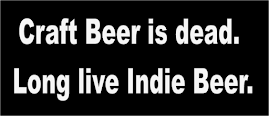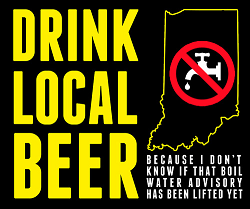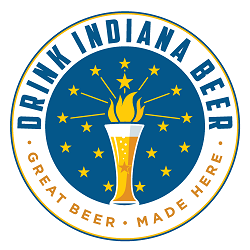(Published at LouisvilleBeer.com on December 23, 2013)
---
It happens each holiday season.
During an otherwise random conversation about Trojan Goose, the superiority of two-way street grids or the many edifying reasons why the Confederacy got whipped in the Civil War in spite of the present-day Republican’s pipe dreams, eventually someone looks at me with dismay.
“Roger, you’re such a Grinch.”
My response never varies: “Thank you very much.”
The roots of my longstanding Yuletide antipathy might be traced to Freudian conceits, Jungian counter-thrusts, references to childhood toilet training habits or the sheer pervasiveness of psychological repression stemming from residency in a fascist state, but in truth, it’s far simpler.
It goes back to that original, defining moment in every American boy’s life – not when it becomes clear that he’ll die some day without the saving grace of being able to hit a curveball, but the sudden, gut-wrenching discovery that in spite of the shameless propaganda fed to us by adults, who’d assured us that excruciating behavioral self-regulation would be rewarded by a gaudily costumed fat man parking his tricked-out sleigh on the roof and descending the chimney, that nope, in the end, it was nothing more than a transparent ruse.
It hits you: Santa Claus doesn’t really exist at all.
Our house didn’t even have a chimney, and you’d think this would have made me suspicious, but I was oblivious. When the shameful day of infamy arrived and my chum chided me — “c’mon, don’t tell me you still believe in Santa?” — I did much more than merely shake Santa’s grip, cold turkey, right there on the spot.
I irrevocably disavowed the whole contrived Christmas spectacle, because even at such a tender age, I could see the dominoes falling as the previously sacrosanct Santa myth vaporized in plain sight. If the grownups could mislead us about Santa, where would it end? They might also be fibbing about those other edicts demanding compliance and conformity, from the civic foundational edifices of religion, patriotism and obedience to the logic of the crosswalk.
The worst of it was sitting alone in my room, cross-legged on the cold tile floor, and experiencing the devastating frustration of knowing that I was far too young to properly drink my way through the rampant disappointment.
Santa’s unused cookies and milk were the best I could do, and then, as now, I detest milk.
—
In 1991, at 31, I spent Christmas in the city of Kosice — now located in sovereign Slovakia, which then comprised the easternmost lands of Czechoslovakia. It was the mid-point of a six-month stint teaching conversational English to doctors and nurses at the city’s main hospital, an experience made possible by the Cold War’s end. Upon returning stateside in 1992, there was a brief break, and then I went into the food and drink business, where I’ve been ever since.
Grinch or not, the approach of the holiday season in Kosice proved fascinating. With no Thanksgiving as mile marker, few signs were evident that that Christmas was coming until the eve of St. Nicholas Day (December 6), when children scrubbed and polished their shoes, placing them on windowsills to be filled with candy and chocolate. Presumably, bad children would receive a bundle of twigs bound together for swatting their butts … as it should be.
In Communist times, the regime attempted to persuade the populace that a chap named Grandfather Frost brought these goodies, presumably on behalf of the benevolent leadership. After the Velvet Revolution in 1989, back came Christmas trees and caroling in the streets, and while these were familiar to me, decorations didn’t even begin to appear until the first part of December. I remarked to my uncomprehending students that they should contrive a holiday like Halloween to mark the true beginning of the shopping season.
Shopping season? It was quite ephemeral. Surely it’s different in 2013, but in 1991, only a few understated window displays were to be seen in shops, and high ¬pressure, guilt laced sales tactics were nowhere to be found. However, one necessary seasonal item became ubiquitous during the week preceding Christmas.
It was carp, raised and fattened in farm ponds, not river bottoms, and brought to market in streetside barrels and oversized plastic tubs. Some buyers brought their own buckets to take the living fish home for a few days of further bathtub cleansing. Others had their purchase killed, weighed and wrapped on the spot.
Carp is the traditional Slovak meal for Christmas, accompanied by an array of special side dishes, and perhaps some steaming sauerkraut soup. There always was plenty of bottled lager beer, but the Christmas Eve toast in 1991 was chased with homemade peach brandy from a student’s village nearby: “To peace, health and a good harvest.”
—
Two or three lifetimes later, there was a second chance to be in Europe for Christmas. I hope it doesn’t prove to be the last.
In 2009, the Baylors stayed in a rental apartment in Bamberg, Germany, a mere stone’s throw from the Fässla and Spezial breweries. With the requisite open-air Christmas market, mulled wine and naturalistic decorations, Franconia’s version of the Yuletide season was obvious without being garish. The Grinch in me was shaken, if as yet unbowed.
On Christmas morning, we strolled through the Altstadt’s deserted streets and climbed Altenburg hill to the medieval castle, affording a sweeping view of the valley and Bamberg’s dizzying number of church spires. Most businesses were closed, but pleasingly, some food and drink purveyors were open in a city blessedly free of the archaic blue laws still existing in Indiana, which prevent alcohol from being served on Dec. 25 – a purely Christian holiday.
Clouds rolled overhead, and it was a bracing and exhilarating walk. Descending the commanding heights back to our riverside starting point, we passed the city museum in the old town hall astride the Regnitz and saw that the doors were open. Inside was a fine collection of 18th century Porcelain from Meissen, and one of 38 nativity scenes on display in and around Bamberg during the holiday season.
A reconnaissance of Ludwigstrasse’s expanse revealed that Bamberg’s Chinese restaurant owners are not as ambitious as metro Louisville’s, with all three closed for the day. However, at the train station, the bakery and small grocery both were open, and I bought a handful of half-liter Schlenkerla Märzen lagers to accompany the evening’s home cooked vegetable soup.
With no close friends in Bamberg, we kept ourselves company, having procured groceries and libations in advance. With bottles of Fässla in support, Christmas evening selections on the telly revealed a diverse Euro holiday tableau.
There was a Basque celebration from Bilbao, with crazy costumes, quasi-operatic tunes and the inexplicable, pre-historic language spoken by the world’s first cod fishermen. The whole time, I kept expecting a Muse concert to break out.
We watched a performance in Salzburg of Mozart’s “The Magic Flute”; snippets of a schlocky Bavarian idyll, rather like the Osmonds meeting Lawrence Welk in lederhösen and dirndls; and then a Berlin performance by Max Raab and the Hotel Palast Orchestra, a stagey society presence reminiscent of Joel Grey’s role in “Cabaret.”
Finally came “City Lights,” the not-so-silent masterpiece by Charlie Chaplin, without dialogue but featuring a musical soundtrack as a concession to new 1931 technology. The Little Tramp falls for a blind flower girl … and meets a drunken millionaire along the way.
On the 26th, Café Abseits beckoned again, with a fine draft list of regional, seasonal Bockbier. Later, at Spezial, delightful Ochsenbrust in
horseradish sauce with a dumpling was accompanied by several of the brewpub’s quintessential smoked lagers.
I don’t “do” Christmas. Occasionally, there are exceptions.













